Have you been thinking about writing a sales plan for your company but aren’t quite sure where to start? Because of how important this document is, we know it can sometimes be a bit overwhelming to get started with it – especially if you are creating one for the first time.
A sales plan outlines your goals, key strategies, target market, and potential challenges. It resembles a conventional business plan but is entirely devoted to your sales approach.
Writing a sales plan is beneficial for business owners, sales reps, and sales managers, whether it be for their company or their team – and with a tool like Xara up their sleeve, sales planning becomes easy and efficient.
If you are looking to increase revenue and upscale your sales strategies, then read on to find out what a good sales plan is all about! In this article, we’ll discuss all the essential aspects of structuring and writing a sales plan, as well as how to successfully use Xara to customize the best sales plan template for your company. Ready to find out more?
How Is A Sales Plan Structured?
 Source
SourceA strategic sales plan must be comprehensive and provide a good overview of what needs to be considered when successfully making sales.
If you want to learn more about what a sales plan is and how it can benefit your company, then check out this article!
From market to revenue targets, here is everything you need to include in your sales plan:
1. Sales Plan Goal
What is the end goal that drives this sales plan? The mission?
Before putting in motion any sort of plan, it’s essential to gain a clear view of what you expect to see at the end of the tunnel. Without clear sales goals being set beforehand, it’s hard to predict what strategy is optimal.
Whether you are looking to increase revenue, boost sales on a specific product, or successfully launch a new product, begin your sales planning by outlining your desired outcome.
2. Target Customers
Who is the company aiming to sell to, and what are their particularities?
Your company’s target customers are the people who are most likely to purchase your goods. By segmenting your target market into smaller, more targeted groups using categories of geographic location, behavior, demographics, and other factors, you may gain a clearer understanding of your target market.
Your entire sales staff needs to be constantly informed on who they are selling to. The target market, target industries, and ideal client profiles that your business aims to reach with its goods and services should all be included in your sales plan.
3. Revenue Goals
What target needs to be hit, either financially or in terms of portfolio expansion?
The amount of money your business hopes to earn during a specific period is its target revenue. You can measure your revenue targets by calculating a growth rate to add to the prior year, projecting revenue based on personnel capacity, or adding up your team’s sales quota. The same thing goes for goals that focus on volume rather than income.
Keep your targets ambitious but realistic – it’s essential to reach for the best possible outcome, but don’t lose sight of what is genuinely achievable.
4. Sales Strategy
What is the game plan for hitting set targets?
Your team’s particular steps to meet revenue goals are known as strategies and tactics. These can vary depending on the sales goals that were set and the target audience. A few examples are:
- Using social media for lead generation
- Asking for referrals
- Retarget previous customers
- Discount prices
- Upsell and cross-sell
The list can go on, as the recipe for success depends on each business and its customers. When creating a sales plan, you should consider all of your options.
5. Overview of Industry/Market
The state of the market provides essential information regarding your industry’s competitive environment. What’s gaining popularity? Where is consumer interest diminishing? Has there been any industry competition that has gained traction, and if so, why? Your sales strategy should be based on how your market is performing.
Understanding your market position can be easier by conducting competitive analysis, SWOT analysis, industry trend reports, and sales forecasting. In order to effectively build your sales plan, you should have a good eye for these things.
6. Sales Team Structure and Deadlines
No sales plan is complete without a detailed description of each team member’s responsibilities, with a timeline of completion.
A company has many moving components. To keep your sales team operating properly, you must establish a schedule and assign responsibilities for each task.
Make sure that roles and duties are clearly assigned and that there are smooth handoffs and communications at each level. All team members can benefit from having insight into the sales funnel and process, which can be assured with the help of a CRM (Customer Relationship Management)
Get started with Xara and make collaborating easier for your team by streamlining online communication – everything in one place!
7. Resources
The most effective tool for carrying out your sales strategy is the team you have on hand, but for that to happen, they require resources. Your team will employ these resources to meet revenue goals.
With the help of Xara, your sales team can perform the necessary analysis, create content, track progress, and employ efficient templates for their sales plans, all with just one powerful tool.
5 Different Types of Sales Plans
Depending on the goals of your company, the type of sales plan that you have to create also varies. Here are a few examples:
1. 30-60-90 Sales Plan
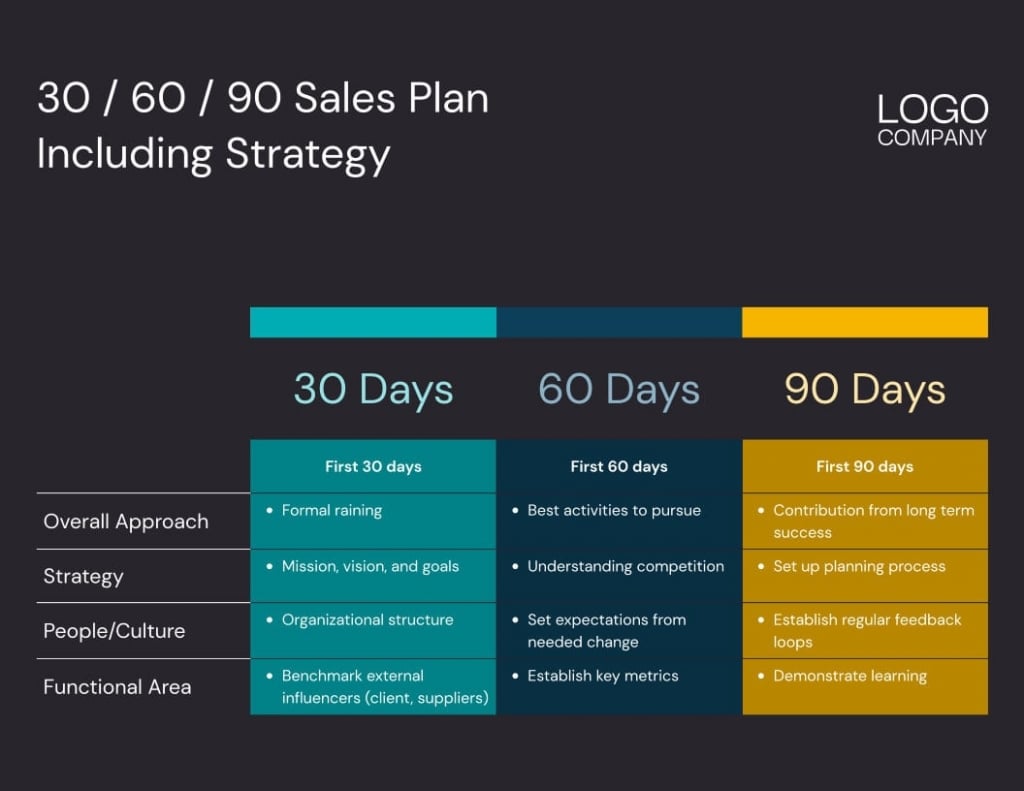
Source: Xara
As the name implies, the 30-60-90 Sales Plan relies on a timeframe – its goal is to outline goals over the course of 3 months:
- One for the thirty-day checkpoint
- One more for the 60-day checkpoint
- The last one is for the 90-day checkpoint.
This is generally used for new members of the sales teams or selling in new territories.
2. Market Expansion Plan
Typically, a market expansion plan defines your approach to entering new target markets. It lays out a to-do list and goal criteria that salespeople must adhere to successfully grow the company into a new market.
When creating this strategy, you must include:
- The price of distribution (if applicable)
- Time zones that separate your sales representatives’ target customers
- Compliance, rules, and other logistical considerations in that sector
3. Go-To-Market Plan
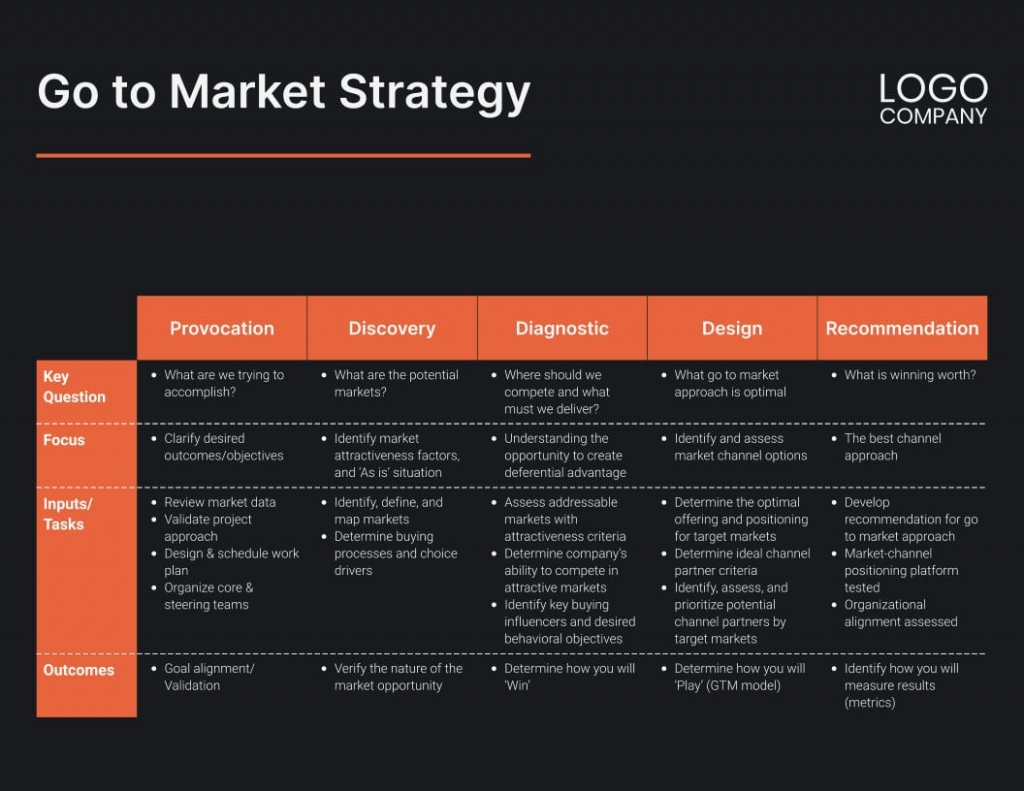
Source: Xara
A go-to-market strategy is a detailed plan used by firms to launch a new good or service. Intended audience profiles, a marketing plan, and a specific sales and distribution strategy are all components of a typical GTM approach, which is intended to reduce the risk associated with the launch of a new product.
4. New Product Sales Plan
This strategic sales plan can be developed prior to the introduction of a new product. This strategy aids in developing a road map for commercializing the new product and successfully earning a profit from it.
5. Territory Sales Plan
To give sales directors more insight into their sales efforts, sales managers in charge of a specific region sometimes employ territory sales plans.
This is a practical strategy used to achieve objectives to gradually develop sales and revenue in the territory and target the proper customers there. A successful territorial sales strategy will describe the region’s market trends, pertinent customer personas, compliance, and policies.
Create A Sales Plan In 7 Steps
 Source
SourceNow that you know what the structure of a sales plan is and some of the options you can choose from when creating one. It’s time to talk about the step-by-step process of creating your own sales plan:
Step 1: Analyze Current Data and Trends
 Source
SourceIn each sales plan, a market overview and analysis are essential. Understanding the position of a company, its product, or its service is crucial. You must be able to describe the unique qualities that set your company apart from competitors. This can quickly be done with the help of charts and data visualization.
Analyzing competition always provides valuable insight. When their items are stronger than yours and vice versa, discuss how your products compare. Talk about their pricing in comparison to yours as well.
Also, bring up current market trends. For example, you should pay attention to what industry-specific software is gaining popularity if you run a SaaS business. Mention the rise of automated mobile ads if you sell advertisements. Make an effort to foresee how these changes may affect your company.
Step 2: Define Your Mission
Once you have your data, identifying the company’s mission, whether it be innovation, improved user experience, or anything else, is the next stage.
The processes should align with brand values no matter what you sell: food, clothing, accessories, or online courses. Data shows that brands with a consistent mission and representation have seen a 33% increase in income.
Step 3: Pinpoint Your Target Market
 Source
SourceKnowing your target demographic is essential whether you’re drafting your first sales plan or your tenth. Who are the most desirable among your clients? Do they all work in the same field? Have the same interests? Fight the same battles?
As your offer and approach develop, and you adjust to product-market fit, this component of your sales plan may also undergo significant changes over time. You could have success selling to startups in the beginning when your product is just taking off, and your prices are low.
Mid-market businesses are probably a better fit when the product is significantly more robust, and the pricing has increased. Therefore, it’s crucial to regularly evaluate and update your buyer personas.
Step 3: Break Down The End Goal Into Objectives With Deadlines
This is precisely what a 30-60-90 Sales Plan does – breaks down the end goal into objectives with monthly deadlines over the course of 3 months. However, this type of sales plan isn’t the only one that requires this step.
Setting smaller objectives that help reach the end goal of the plan is an imperative step, no matter if you’re tapping into a new market, launching a new product, or just looking to improve your general sales.
In order for the timeframe you set in place to be accurate and realistic, companies employ the help of what is known as sales forecasting – the process of anticipating a company’s sales revenue for a given time period, usually a month, quarter, or year.
The success of a company depends on creating a precise sales projection. It affects everything from hiring to wages, compensation, inventory control, and promotion. If a projection is wrong, your company may swiftly lose trust, so take forecasting seriously!
Step 4: Determine KPIs
Sales KPIs (key performance indicators) transform unprocessed data into vital business metrics that can be used to assess how well an organization’s operations are aligned with its objectives. KPIs can be connected to financial data or progress made by an individual or a team.
Sales KPIs are used by businesses to assess and enhance the performance of their sales teams, streamline the revenue process, and increase sales.
Given the importance of KPIs in ensuring successful selling, it’s quite clear why they shouldn’t miss from your sales process. And, to make them easier to analyze, don’t shy away from representing these metrics visually!
7 Important KPIs to Consider For Your Sales Plan
 Source
SourceThere is a very large number of KPIs that can be tracked, but here are a few that we deem the most important:
1. Monthly Sales Growth
Without increasing sales, a company can only exist for a limited time. The ability to measure this metric allows executives to identify issues and take action on patterns promptly.
Realistic monthly sales growth targets can inspire a sales team and guarantee that their efforts are consistently in line with those of the organization.
2. Sales Opportunities
Teams can estimate sales and choose which leads are worth pursuing by tracking sales possibilities. Increased sales prospects suggest the potential for larger sales while declining opportunities can suggest that more sales effort is needed.
3. Sales Target Attainment
Will the sales team meet their quotas, which are also known as sales targets? Are actual sales higher or lower than expected? Which salesperson is struggling and could use some advice? These questions can be resolved using the KPI for sales target attainment.
4. Product Performance
Which products are the most popular, and which are less popular? These queries are addressed by this KPI, which ranks products according to sales.
Product sales volume and revenue performance are not always correlated. Although they might not be among the top revenue-generating products, low-priced but high-volume goods might make up a sizeable amount of overall sales. With this KPI, it’s necessary to consider the product’s external environment.
Sales managers can utilize product performance to modify their sales plan in response to these trends, and sales executives can use the rankings to assess the trends in the product market.
5. Customer Acquisition Cost
The expense of acquiring one new customer is referred to as the customer acquisition cost. The acquisition costs vary depending on the business model, but a thorough calculation can be ensured by accounting for all sales and marketing costs, including salaries and overhead.
Growing average revenue per client and customer lifetime value while lowering customer acquisition expenses can support maintaining or improving profitability.
6. Conversion Rate
This is the proportion of leads generated by each salesperson that result in closed sales. Per rep, quarterly tracking is the norm.
If the conversion rate of a single sales representative exceeds the desired conversion rate, that rep may be employing sales tactics or procedures that are exceptionally efficient and can be implemented across the board. If lower, you may need to adjust or streamline your sales strategies to boost conversions.
7. Customer Retention
Even if they increase sales, new customers require many resources to acquire. You can increase ROI by keeping an eye on customer retention and concentrating on upsell and cross-sell opportunities while generating predictable revenue from a base of devoted clients.
In order to make sure that your team is prioritising current customer relationships, you may need to review rep engagement techniques if you notice a decline in customer retention.
Step 5: Evaluate Resources For Your Sales Plan
First and foremost, your resources are your sales representatives. They will be responsible for the sales process and turn the plan into reality. However, they can’t do that without the necessary tools.
With a platform like Xara, their job is made 10 times easier. In one place, they can:
- Create a sales plan
- Analyze data about how their audience engages with their content
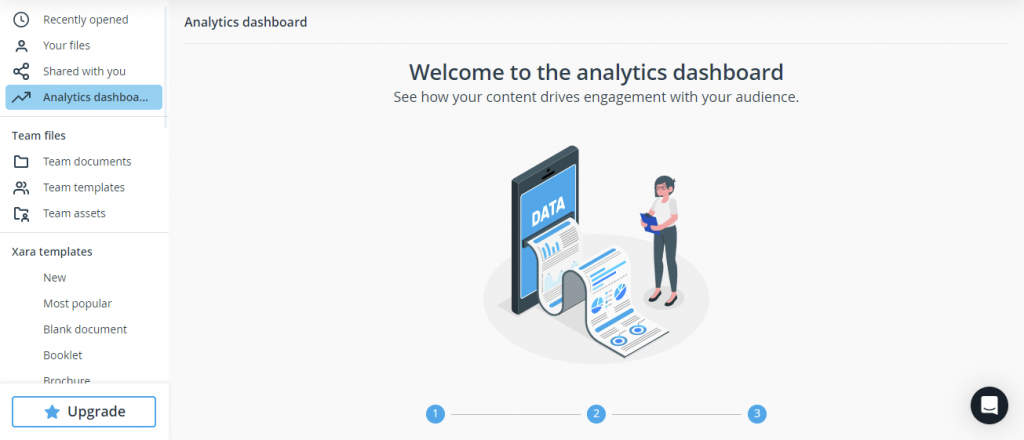
- Handle content branding through easy logo importing, font styling, and color scheme generation
- Design content through professional graphic design solutions for web and print
Step 6: Determine The Budget
In order for the previously mentioned resources to be ensured for the team, it’s important to properly budget your strategic sales plan. When figuring out this budget, a few of the most important things to take into consideration are:
- Salaries
- Tool pricing
- Training
- Travel (if it applies)
- Resources for your team (from electronics to food)
If you want your budgeting to be more accurate, also keep an eye on your sales forecasting!
Step 7: Establish a Sales Strategy
Up until this point, you’ve established your goal and backed it up with vital data. Now, it’s time to figure out how you are going to act to reach your targets and increase sales and revenue.
Describe your pricing structure and any upcoming discounts or promotions. What crucial steps will you take to raise brand recognition and produce leads? Essentially, this is the step in your sales planning where you figure out an actionable way in which everything you’ve forecasted becomes a reality.
Sales Plan Templates
Creating a sales plan with Xara is easy and intuitive. All you have to do is:
1. Sign In or Get Started
Depending on whether you’ve used Xara before, either sign in to your account or create a new one and sign up for your 14-day free trial.
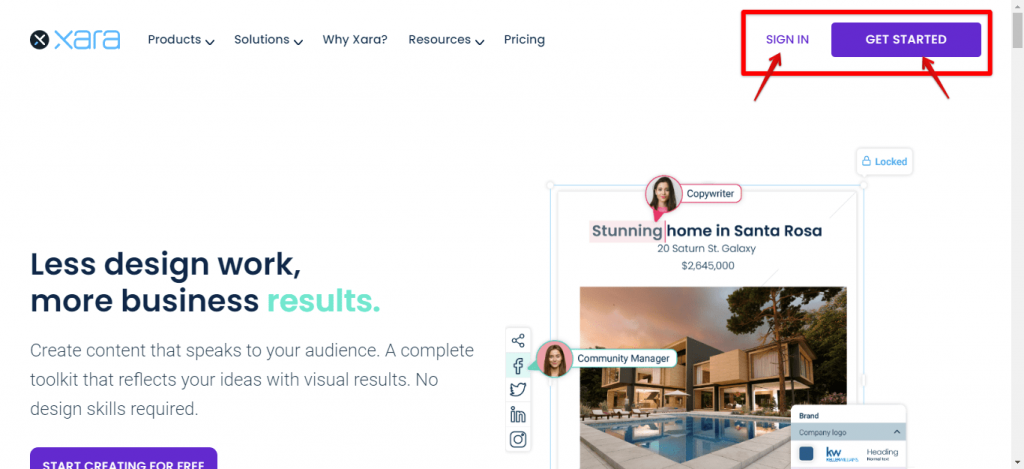
2. Find Xara Templates
You are now looking at your Xara dashboard! On the left side of the screen, among other great features, you will find Xara Templates.

3. Locate “Strategy & Planning.”
This is the Xara template section you will use to create a sales plan.

4. Choose Your Sales Plan Template
There are plenty of templates to choose from for your sales plan, depending on your preferences!

5. Automatically Apply Your Brand To The Template
Brand consistency is vital for your business and even more so for your sales strategy. Always making sure that your content represents your brand is key, and this applies to your sales plan as well.
Xara makes branding your documents more effortless than ever through its Smart Branding Toolkit.
Once you’ve opened your preferred template, just click on the “Brand” button, enter your website URL, and watch the magic happen as Xara automatically imports your logo, fonts, and color scheme.
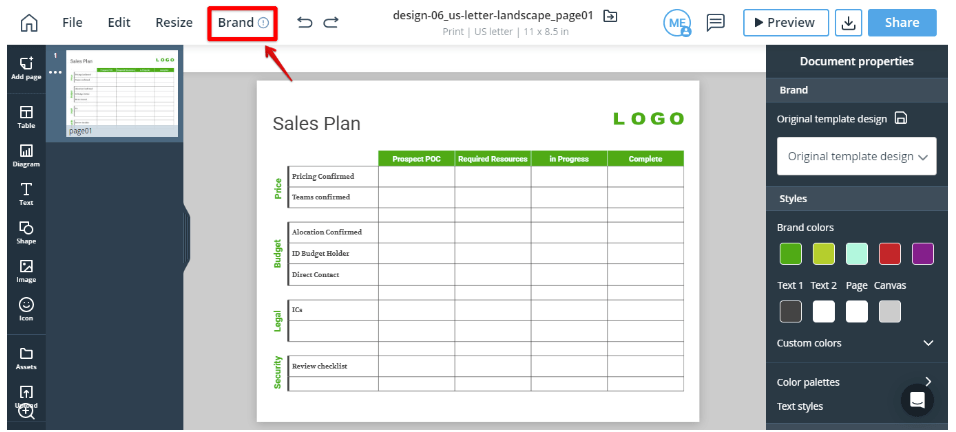

Once Xara has created your brand, you will notice that the platform automatically adds it to all your content.

6. Edit Your Sales Plan
All of our templates are 100% customizable – be sure to make them your own!
Use our templates, follow our step-by-step guide, and create the perfect sales plan for your company’s goals.
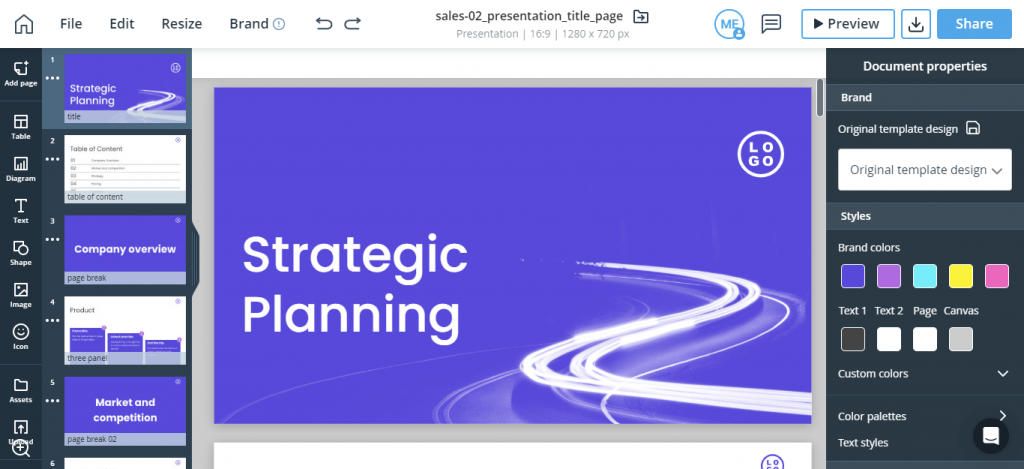
Start Making Your Sales Plan With Xara
Now that you’ve finished reading our guide, don’t you feel like creating a sales plan is much less of a mystery?
No matter what type of sales plan you opt for, some things should never miss. Without an overview of the market, previous sales data, and a deep understanding of the target customers, it’s hard to be able to build a successful strategy for boosting sales.
If you carefully follow the steps, from defining goals to setting deadlines and allocating resources, you will ensure that your sales plan is perfectly built to aid in helping your company ring in more sales.
Creating a well-structured sales plan lays the groundwork for an efficient selling strategy. And what better way to ensure you reach your sales targets than by using one of the best sales tools out there?
There are plenty of sales plan templates waiting for you on Xara Cloud – all you need to do is sign up and start using them to build the best sales strategy for your company!
Create your winning sales plan today!



 No credit card or phone number required.
No credit card or phone number required.